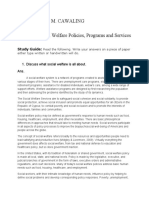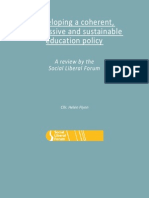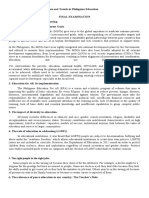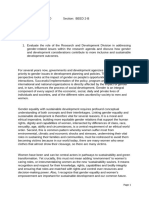0 ratings0% found this document useful (0 votes)
62 viewsBlog 2: Communication Policies at Different Levels: International, Regional, National, and Local
Communication policies exist at multiple levels - international, regional, national, and local. They aim to coordinate communication systems and avoid contradictions between public and private entities. While many African countries have policies for specific sectors like education and health, some exist more on paper than in practice. An effective communication policy can consolidate actions across sectors and support the systematic planning and use of communication resources to enhance national development.
Uploaded by
Tzeri VicenteCopyright
© © All Rights Reserved
Available Formats
Download as DOCX, PDF, TXT or read online on Scribd
0 ratings0% found this document useful (0 votes)
62 viewsBlog 2: Communication Policies at Different Levels: International, Regional, National, and Local
Communication policies exist at multiple levels - international, regional, national, and local. They aim to coordinate communication systems and avoid contradictions between public and private entities. While many African countries have policies for specific sectors like education and health, some exist more on paper than in practice. An effective communication policy can consolidate actions across sectors and support the systematic planning and use of communication resources to enhance national development.
Uploaded by
Tzeri VicenteCopyright
© © All Rights Reserved
Available Formats
Download as DOCX, PDF, TXT or read online on Scribd
You are on page 1/ 2
Blog 2: Communication Policies at Different Levels: International, Regional,
National, and Local
The relationship between information flows and national or local-level
development have become better understood in recent years; as has the role of
communication processes in mediating social and individual change. However, in most
African countries these relationships are not widely discussed or easily accepted,
especially by development planners. Basically, communication is a social process that
produces changes in the knowledge, attitudes and behaviours of individuals, and
groups, through providing factual and technical information, through motivational or
persuasive messages, and through facilitating the learning process and social
environment. These results might then lead to increase in the mastery of crucial skills by
the individual, and to enhancing the achievement of various instrumental goals. Other
possible consequences of communication include enhancement in self-esteem and
wellbeing through participation in community and social life, increasing the individual’s
perceived efficacy in dealing with other people, reinforcing mutual respect and
enhancing confidence among social groups and building trust within communities.
These outcomes are the ingredients that contribute to the creation of those positive
individual, community and societal changes that together are often referred to as
development. Communication can thus positively influence development. But using
communication for development means different things to different people. It has even
been viewed differently in different eras, considered variously as social engineering or
giving voice to the voiceless. Both as idea and as practice, the relationship of
communication to development has been problematic, as it has raised many questions.
Government and other institutions create policies to ensure coherence and to
avoid contradictions in the actions of various public and private entities. Policy
instruments also seek to solve social and technical problems and to legitimise the
implementation of programs and projects. African countries are not strangers to policy-
making. Most countries already have policies in various sectors; some of them well
articulated, for example, an economic policy, a health policy, an agricultural policy, an
educational policy, an environmental policy and a foreign policy. In some countries
these are merely cosmetic documents virtually moribund, with no living dynamic reality,
and not much possibility of being implemented. In other countries these policies provide
sectoral orientations that can contribute to the overall goals of national development. In
that context, a communication policy may be seen as a further contribution to the
national development environment through consolidating actions around issues that cut
across several sectors.
As far as communication policies are concerned, they have been described as:
Sets of principles and norms established to guide the behaviour of communication
systems. They are shaped over time in the context of society’s general approach to
communication and to the media. Emanating from political ideologies, the social and
economic conditions of the country and the values on which they are based, they strive
to relate these to the real needs for and the prospective opportunities for
communication. In every society, public and private institutions and individuals
undertake internal and external communication for many reasons. There is often no
over-arching idea or vision to help coordinate or rationalise these various actions,
probably because policy-makers and planners do not see how they can be related.
In the past year, there has been much debate about campaigning for a ‘New
Settlement’ (Clarke and Woodhead 2015) for religious education in England, which
would involve a change to the law and national policy. The debate has been informed
by two further important reports and an edited book all underlining the need for
improved ‘religious literacy’ in both schools and public life (CORAB 2015; Dinham and
Francis 2015; Dinham and Shaw 2015). Main issues currently being discussed in
relation to religious education are whether religious education would be better with a
statutory national curriculum rather than being organised locally as at present, with non-
statutory national guidance; whether the parental right of withdrawal should be
abolished; the place of non-religious worldviews in examination syllabuses and more
generally and whether the name of the subject should be changed. There is a strong
lobby arguing that the local organisation has broken down because of changes in local
government funding and in the way many state-funded schools are now free from local
authority control (‘Academies’ and ‘Free Schools’). A statutory national-level curriculum
could strengthen the subject and make things simpler for all concerned. On the other
hand, there is the danger of losing the grass-roots input and valuable relationships as
well as professional development built up at local level as teachers, local politicians and
religious communities worked together on a local Agreed Syllabus and in local Standing
Advisory Councils on Religious Education. Even if the ‘religious education community’
agrees on the best way forward, we then have to persuade government to make the
required changes. The Religious Education Council is about to launch a Commission to
look into all this.
Whatever the outcome, the case studies in this issue demonstrate that the best
of policy and curriculum guidelines national or local will only result in better religious
education if teachers are enabled to take ownership and put them into practice so the
most important way forward is to invest in teacher education, both initial training and
continued professional development.
A communication policy can, therefore, be an instrument for supporting the
systematic planning, development and use of the communication system, and its
resources and possibilities, and for ensuring that they function efficiently in enhancing
national development.
You might also like
- National Curriculum Standards For Social Studies100% (2)National Curriculum Standards For Social Studies9 pages
- Education Policy, Theories, and Trends in The 21st CenturyNo ratings yetEducation Policy, Theories, and Trends in The 21st Century169 pages
- Presentation SG9a - Developing Thinking Skills - How Children Learn Math100% (2)Presentation SG9a - Developing Thinking Skills - How Children Learn Math25 pages
- Blog 3: Blog 3: Implication of Communication Policies To Communication Systems PlanningNo ratings yetBlog 3: Blog 3: Implication of Communication Policies To Communication Systems Planning2 pages
- Making Politics Work: Practical Lessons on Politics for Would-Be Education ReformersFrom EverandMaking Politics Work: Practical Lessons on Politics for Would-Be Education ReformersNo ratings yet
- Citizen Participation As A Factor of Resilience in The Education Sector in The Face of The Effects of The PandemicNo ratings yetCitizen Participation As A Factor of Resilience in The Education Sector in The Face of The Effects of The Pandemic6 pages
- Educational Policy and Planning-DR R.BhowonNo ratings yetEducational Policy and Planning-DR R.Bhowon6 pages
- Addressing Barriers To Student LearningNo ratings yetAddressing Barriers To Student Learning49 pages
- Director, Advocacy and External Engagement PDFNo ratings yetDirector, Advocacy and External Engagement PDF3 pages
- This Goal Coupled With The REFLECT Approach That Government HasNo ratings yetThis Goal Coupled With The REFLECT Approach That Government Has3 pages
- Effect of Social Orientation and Community Extension Program to the Core Values of Selected Business Administration Students at Lipa City CollegesNo ratings yetEffect of Social Orientation and Community Extension Program to the Core Values of Selected Business Administration Students at Lipa City Colleges9 pages
- 8611 Assignment No 1 Solutions by Mohammad Ali AsifNo ratings yet8611 Assignment No 1 Solutions by Mohammad Ali Asif12 pages
- Grand Challenges in Public Administration Implications For Public Service Education Training and ResearchNo ratings yetGrand Challenges in Public Administration Implications For Public Service Education Training and Research7 pages
- Mary Grace M. Cawaling BSSW - 2A SW 221 - Social Welfare Policies, Programs and ServicesNo ratings yetMary Grace M. Cawaling BSSW - 2A SW 221 - Social Welfare Policies, Programs and Services4 pages
- Re-Framing Education Policy - Developing A Coherent, Progressive and Sustainable Education PolicyNo ratings yetRe-Framing Education Policy - Developing A Coherent, Progressive and Sustainable Education Policy13 pages
- Contemporary Issues and Trends in Philippine EducationNo ratings yetContemporary Issues and Trends in Philippine Education2 pages
- A Concise Reader For Public Policy (Final Edited Version)No ratings yetA Concise Reader For Public Policy (Final Edited Version)77 pages
- The Role of Community Sector Peak BodiesNo ratings yetThe Role of Community Sector Peak Bodies5 pages
- Decentralisation of Education in Cambodia: Searching For Spaces of Participation Between Traditions and ModernityNo ratings yetDecentralisation of Education in Cambodia: Searching For Spaces of Participation Between Traditions and Modernity13 pages
- PRINT READY 11808 - 19 B NPF Consultation Document 2019 - Education - (POTTS) PDFNo ratings yetPRINT READY 11808 - 19 B NPF Consultation Document 2019 - Education - (POTTS) PDF8 pages
- Stronger Families and Communities StrategyNo ratings yetStronger Families and Communities Strategy16 pages
- _SECTOR RESEARCH_1E-CEAFA 2_BELZA-GIMORO-MARCAIDANo ratings yet_SECTOR RESEARCH_1E-CEAFA 2_BELZA-GIMORO-MARCAIDA8 pages
- TR Community Based Awareness Attitudes BehaviourNo ratings yetTR Community Based Awareness Attitudes Behaviour32 pages
- International Handbook of Globalisation, Education and Policy Research (2021)No ratings yetInternational Handbook of Globalisation, Education and Policy Research (2021)1,112 pages
- Inclusive Planning For Social Integration: A Short NoteNo ratings yetInclusive Planning For Social Integration: A Short Note7 pages
- Progressive Families, Progressive Britain: Why Britain Needs Family Proofing of PolicyNo ratings yetProgressive Families, Progressive Britain: Why Britain Needs Family Proofing of Policy18 pages
- Blog 4: Implication of Communication Policies To Communication Systems PlanningNo ratings yetBlog 4: Implication of Communication Policies To Communication Systems Planning2 pages
- Blog 1: Overview of Communication Policies and PlanningNo ratings yetBlog 1: Overview of Communication Policies and Planning2 pages
- ADDTOP SE Series Inkjet Printer (SE 1601)No ratings yetADDTOP SE Series Inkjet Printer (SE 1601)3 pages
- Technical Assistance Agreement Contract: KRA Hindering FactorNo ratings yetTechnical Assistance Agreement Contract: KRA Hindering Factor3 pages
- AGG 112 Agricultural Extension and Rural Sociology Module (1) - 1No ratings yetAGG 112 Agricultural Extension and Rural Sociology Module (1) - 1107 pages
- Minutes of The Meeting (Discussing Feedback)100% (3)Minutes of The Meeting (Discussing Feedback)2 pages
- Internship PROJECT RECORD STARTING PAGES (1)No ratings yetInternship PROJECT RECORD STARTING PAGES (1)9 pages
- Updated Complete Handouts EDU305 (Lec 1-45)No ratings yetUpdated Complete Handouts EDU305 (Lec 1-45)289 pages
- What Are Variables? - Lesson Plan: Class: Date: Standard(s)No ratings yetWhat Are Variables? - Lesson Plan: Class: Date: Standard(s)3 pages
- Attachment 1 Notification - Regarding Summer Term 2020No ratings yetAttachment 1 Notification - Regarding Summer Term 20201 page
- Monitoring and Evaluation Tool: As of School Year 2020-2021No ratings yetMonitoring and Evaluation Tool: As of School Year 2020-20218 pages
- Improving Students' Speaking Achievement Through Public Speaking TasksNo ratings yetImproving Students' Speaking Achievement Through Public Speaking Tasks8 pages
- Good DESIGN THINKING Book by Dharam MentorNo ratings yetGood DESIGN THINKING Book by Dharam Mentor78 pages
- Week 2 2nd English Reinforcement Classes 2024-2025No ratings yetWeek 2 2nd English Reinforcement Classes 2024-20255 pages
- Health7 - q1 - Mod3 - Changes That Happen To Adolescents - FINAL08032020100% (1)Health7 - q1 - Mod3 - Changes That Happen To Adolescents - FINAL0803202023 pages
- Games_based_learning_in_mathematics_education_A_syNo ratings yetGames_based_learning_in_mathematics_education_A_sy10 pages
































































































